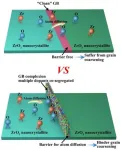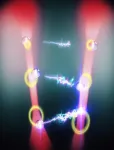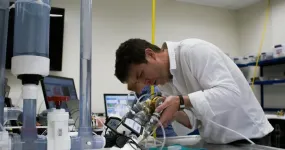To date, ceramic scientists have devised various strategies to impede grain coarsening. The utilization of nano-sized precursor powder can not only facilitate the densification process, but also yields bulk ceramics with reduced grain sizes compared with micron-sized precursor powder. Rapid sintering by passes the low-temperature surface diffusion stage and directly enters the high-temperature sintering stage through rapid heating, rendering it an effective way to inhibit grain coarsening. However, these aforementioned strategies fail to prevent coarsening during the application of nano-ceramics in medium- or high-temperature environments. The introduction of secondary phase can also enhance thermal stability of nanograins. By pinning GBs and reducing their mobility, secondary phase effectively inhibits coarsening. However, it is challenging to achieve uniform distribution of secondary phase, which may cause detrimental effects on other properties. Solute segregation at GBs has been shown to reduce GB energy and weaken the driving force of grain growth. Nevertheless, most reported studies have only investigated the addition of one or two types of solute atoms, limiting the extent of GB energy reduction. Therefore, further exploration is needed to fully understand and harness the potential of solute segregation as a strategy.
Recently, a team of material scientists led by Le Fu from Central South University, China proposed an effective strategy to inhibit grain coarsening by constructing GB complexions with multiple dopants co-segregated. As a demonstration of the feasibility of the strategy, multiple selected dopants were doped to a ZrO2-SiO2 nanocrystalline glass-ceramic (NCGC) to form GB complexions. The microstructure of the GB complexions with multiple dopants co-segregated was characterized. Meanwhile, the underlying mechanisms of the effects of GB complexions on inhibiting coarsening were discussed.
The team published their work in Journal of Advanced Ceramics on March 28, 2024.
“In this report, we aimed to construct multi-element co-segregated GB complexion. The first as well as the most important question is to select the dopants. It has been proved that GB segregation is largely affected by the ionic radius and valence state of both dopant cations and the host one. For dopant ions that have large ionic radius mismatch (ε) with the host Zr+4 ion (84.0 pm), they would be pushed to the GBs, instead of dissolving in ZrO2 lattices. In addition, ZrO2 GBs are positively charged, and dopant ions with valence states lower than +4 can form a negative space charge cloud at the GBs, which could also enhance the GB segregation tendency of the dopant ions. Taking the above two criteria into consideration, we selected five dopant ions, i.e., Cs+, Ba+2, La+3, Ca+2, Al+3 ions. They all had large ε with the host Zr+4 ion and their valence states were lower than +4. Hence, theoretically, they should co-segregate at the ZrO2 GBs.” said Le Fu, associate professor at School of Materials Science and Engineering at Central South University (China), an expert whose research interests focus on the field of ceramics.
“We characterized the GB complexions with TEM techniques and found that Y, Ca, Ba, and La elements showed significant segregation at the GB complexion with a thickness of 2.5 nm. Meanwhile, lattice fringes were formed at the GB complexion, indicating that the GB complexions were crystalline superstructures. In addition, we also obtained a full 3D reconstruction of GB complexions on the atomic scale using atom probe tomography (APT), which significantly enhanced our understanding on 3D microstructure of GB complexion,” said Le Fu.
“To investigate the effects of the GB complexion on the grain coarsening behaviors of ZrO2 NCs, the multi-element co-doped and un-doped 65%ZrO2-35%SiO2 samples were annealed at different temperatures, with the un-doped samples as control group. The ZrO2 NCs in the as-sintered sample had an average value of 40.8 nm. Compared with sizes of ZrO2 NCs in the as-sintered sample, those in the 1200 ºC-annealed sample increased by 117.6%, indicating that the ZrO2 NCs showed very strong coarsening kinetics. In comparison, compared with sizes of as-sintered ZrO2 NCs in the multi-element co-doped sample, those in the 1200 ºC-annealed sample increased by only 19.8%, indicating that the GB complexions contributed to the strong coarsening resistance of ZrO2 NCs,” said Le Fu.
However, liquid phase sintering occurred in the multi-elements co-doped sample, so that the sizes of as-sintered ZrO2 NCs in the co-doped sample were much larger than those of in the un-doped sample. Our future work should focus on optimizing the dopants to avoid the occurrence of liquid phase sintering.
Other contributors include Gabriel Arcuri and Kathryn Grandfield from McMaster University, Canada; Wenjun Yu, Zihua Lei, and Ying Deng from School of Material Science and Engineering, Central South University, China; Bohan Wang from State Key Laboratory of New Ceramics and Fine Processing, Tsinghua University, China.
This work was supported by the National Natural Science Foundation of China (52102084). Natural Science Foundation of Hunan Province (2022JJ30718).
About Author
Le Fu holds a BSc in material science from China University of Geosciences (Wuhan), and an M.S. in metals from Central South University (China) and Ph.D. in bioceramics from Uppsala University (Sweden). After graduation, he joined Central South University as a lecturer. He is now an associate professor at School of Materials Science and Engineering at Central South University in Hunan Province, China. His current interests and fields of research include: (1) Development novel nanocrystalline-amorphous heterogeneous biphase ceramics; (2) Preparation, microstructure and property characterizations of high-strength and high-transparency ZrO2-SiO2 nanocrystalline glass-ceramics; (3) Microstructure characterization of nanoceramics with advanced electron microscopy techniques; (4) Study on macroscopic and micro-nano mechanics of nanoceramics and ceramic matrix composites. He has published more than 50 papers in peer-reviewed international journals.
About Journal of Advanced Ceramics
Journal of Advanced Ceramics (JAC) is an international academic journal that presents the state-of-the-art results of theoretical and experimental studies on the processing, structure, and properties of advanced ceramics and ceramic-based composites. JAC is Fully Open Access, monthly published by Tsinghua University Press, and exclusively available via SciOpen. JAC’s 2023 IF is 18.6, ranking in Top 1 (1/31, Q1) among all journals in “Materials Science, Ceramics” category, and its 2023 CiteScore is 21.0 (top 5%) in Scopus database. ResearchGate homepage: https://www.researchgate.net/journal/Journal-of-Advanced-Ceramics-2227-8508
About SciOpen
SciOpen is an open access resource of scientific and technical content published by Tsinghua University Press and its publishing partners. SciOpen provides end-to-end services across manuscript submission, peer review, content hosting, analytics, identity management, and expert advice to ensure each journal’s development. By digitalizing the publishing process, SciOpen widens the reach, deepens the impact, and accelerates the exchange of ideas.
END







